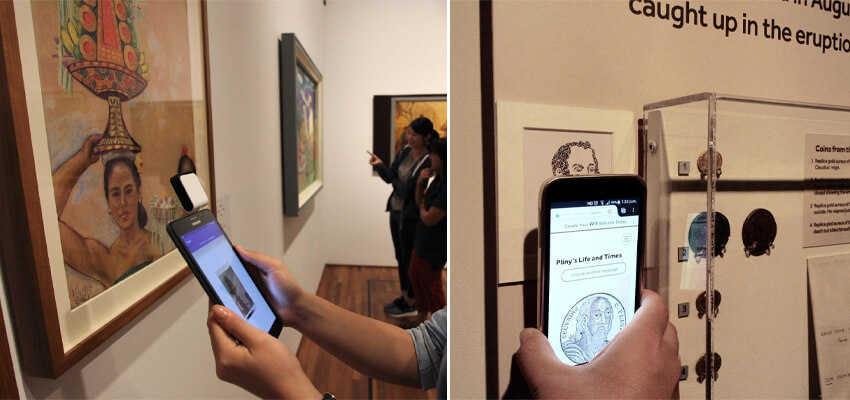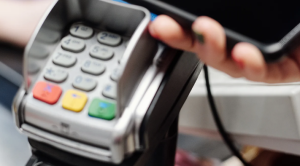The use of RFID (radio-frequency identification) technology is growing in many different industries, and the museum sector is no exception.
Museums use RFID to track inventory, manage security, and even create interactive exhibits. This technology offers many benefits for museums, including increased efficiency and security.
One of the most exciting applications of RFID in museums is the creation of interactive exhibits. We look at this and other ways RFID is making its mark in museums.

What is RFID, and How Does it Work?
Before we dive into the uses of RFID in smart museums, it’s critical to have a basic understanding of how the technology works.
RFID (Radio Frequency Identification) is a type of wireless communication that uses radio waves to exchange data between devices. It works with the help of RFID tags and RFID readers.
RFID tags are attached to objects and contain data that can be read by an RFID reader/scanner. The data stored on an RFID tag can identify the object to which it is attached.
There are many different types of RFID tags, but the most common type used in museums is the passive HF (high-frequency) tag. These tags have a range of up to 10cm and can be read by HF RFID readers.
How Are Museums Using RFID?
Museums are using RFID technology in a variety of ways, including:
- Security Management
Museums contain antiques and other valuable items that can attract thieves. Most museums globally report millions of dollars in losses each year due to theft.
Due to this, museums have started using RFID to increase security. RFID tags are attached to objects and linked to a security system. If an object is removed from its display case, an alarm is triggered, and the object can be located quickly.
This way, museums can deter thieves and protect their valuable collections. It will also help museums to always know the location of their pieces and quickly track down any that are missing.
- Inventory Management
Museums have a lot of inventory, and it can be difficult to keep track of everything. RFID can help with this by automatically tracking inventory.
RFID tags are attached to objects, and the data is stored in a central database. This way, museum staff can quickly and easily see what objects are on display, in storage, or have been loaned out.
This is a much more efficient way to manage inventory than the traditional pen-and-paper method. It will help to prevent loss or misplacement as the system can quickly identify any missing pieces.
- Interactive Exhibits
One of the most exciting uses of RFID in museums is to create interactive exhibits.
In these exhibits, visitors can use an RFID-enabled device to scan tagged objects and learn more about them. This technology allows museums to create a more engaging and interactive experience for visitors.
It also gives museums the ability to provide more information than what is possible with traditional exhibits. For example, an exhibit on the history of a particular object can include audio, video, and text content linked to the object’s RFID tag.
- Simplifies Data Analytics
Most museums generate a large amount of data each day. This data can track visitor behavior, understand exhibit engagement, and evaluate the overall museum experience.
However, manually tracking and analyzing this data is time-consuming and expensive. RFID can simplify this process by automatically collecting data about visitors as they move through the museum.
This data can then be analyzed to generate reports and insights that will help museums improve the visitor experience.
A Museum RFID System
Now that we’ve looked at how RFID is used in museums, let’s look at how an RFID system works. An RFID system consists of three main components: tags, readers, and a central database.
- RFID Tags
These are the tags that are attached to museum objects. They come as either active or passive tags.
Active RFID tags have their power source and can broadcast their data over long distances (up to 100m). Passive RFID devices do not have their power source and rely on the radio waves emitted by an active RFID device to power them.
Passive RFID tags are used more often in museums as they are less expensive and have a shorter range. They are quite inexpensive to maintain.
However, active tags can be used in larger museums, or if a museum wants to track objects over a longer distance. This is particularly necessary when tracking high-value items that carry unmatched significance to a country or the world.
- RFID Readers
These devices are used to read the data stored on an RFID tag. RFID readers come in numerous diverse shapes and sizes. Some of the common ones include:
- Handheld RFID Readers. These are portable devices that can be used to scan RFID tags. They can be carried around by museum staff or used at security checkpoints. These are used when it is necessary to scan a large number of tags, such as when inventory is being taken.
- Fixed RFID Readers. These are mounted on walls or ceilings and used to track the movement of people and objects. They are often used in combination with CCTV cameras to provide security and improve visitor flow management.
These readers can be used to trigger events, such as an alarm, when an object leaves a particular area. As such, they are an important part of any security system.
- Software System
A software system is used to manage the data collected by RFID tags and readers. This system includes a central database that stores all the data, and software used to analyze this data.
The software can generate reports on visitor behavior, exhibit engagement, and much more. It can also trigger alarms or events, such as when an object leaves a particular area.
This system improves the overall museum experience by providing insights that can be used to make changes and improvements.
Relevant articles
- Why are more libraries using RFID technology?
- RFID Animal Tracking and Identification
- RFID for Access Control Management You Would Like to Know
- The Ultimate Guide to Know RFID Asset Management
- Deeply Dug: RFID for Tracking
- 9 Common Applications RFID in Hospitals
- How does RFID revolutionize manufacturing?
- How RFID Technology Changes the Garment Industry?






